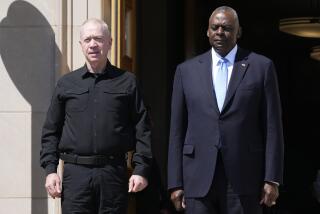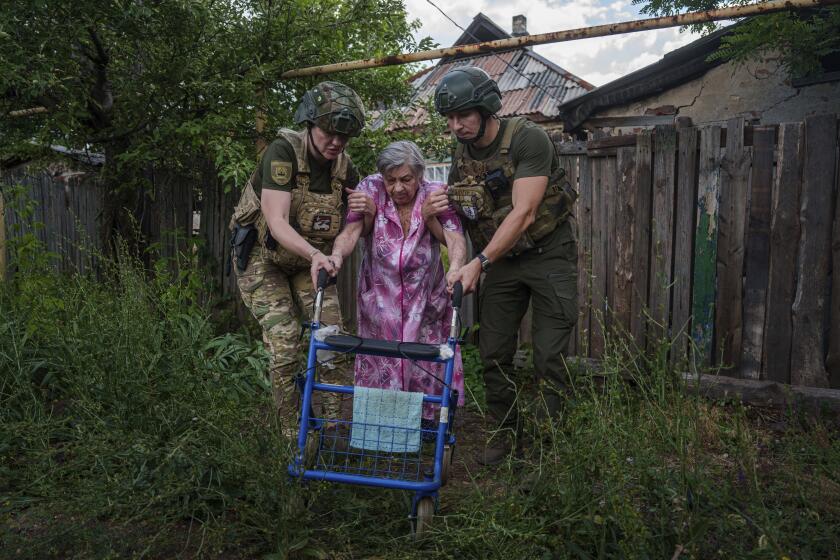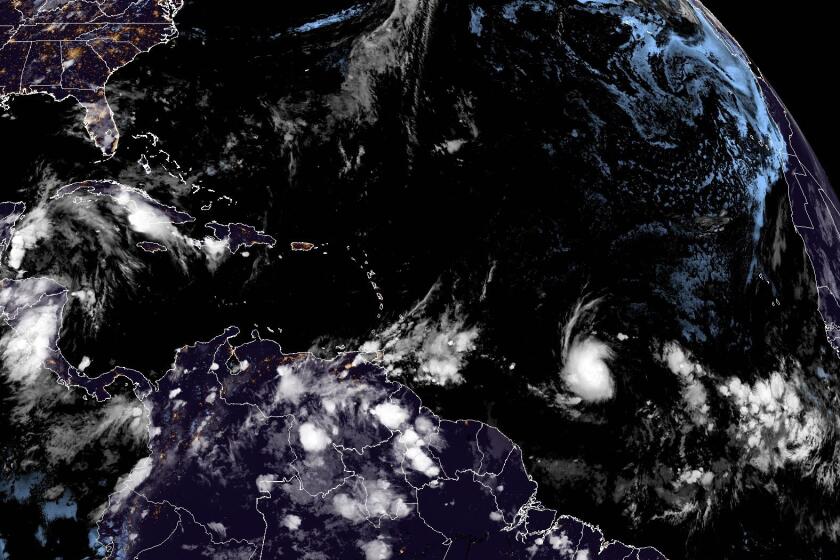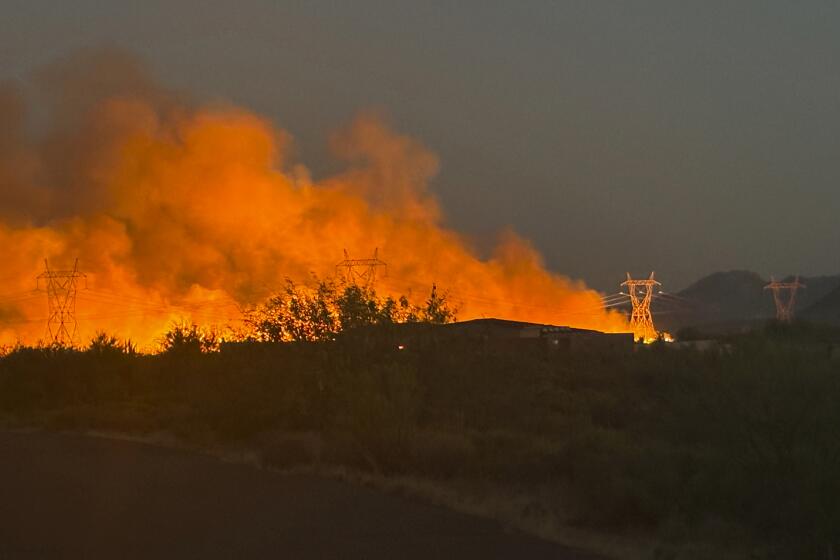U.N. Forces Attack Somali Weapon Sites : Africa: U.S.-led assault targets clan leader Aidid’s radio station, compounds and warehouses in retaliation for the ambush-killing of 23 Pakistani peacekeepers.
U.N. forces in Somalia, including 1,200 American soldiers and heavily armed AC-130H gunships, attacked strongholds of Somali clan leader Mohammed Farah Aidid early today in Mogadishu in retaliation for the ambush last weekend of 23 Pakistani peacekeeping troops.
The U.N. attack, coordinated by the United States, concentrated on blowing up four weapons compounds and warehouses belonging to Aidid and taking over a radio station he had been using as a command center, the Pentagon said. There was no immediate report of casualties.
U.S. officials said the main purpose of the attack was to punish Aidid, who was believed to have ordered the ambush last Saturday that killed the Pakistani soldiers, and to serve notice to other clan leaders that the United Nations will not tolerate further violence.
The United Nations ordered the immediate arrest of Aidid and his four top lieutenants. His capture would mark the first time during the entire Somalia operation that U.N. forces have detained a major clan leader.
Today’s attack was authorized personally by President Clinton, who met earlier in the day with Defense Secretary Les Aspin, Gen. Colin L. Powell, chairman of the Joint Chiefs of Staff, and other national security advisers.
Clinton Administration strategists have been fearful that failure by the United Nations to retaliate for the ambush would irreparably damage the credibility of the peacekeeping operation and of similar U.N. ventures around the globe.
Clinton had no immediate comment, but after the fighting began, Aspin issued a statement saying the military response was “essential if the U.N. is to be able to continue its long-term humanitarian relief and reconstruction efforts in Somalia.”
In line with current U.S. military doctrine, the U.N. action was swift, using overwhelming force, with the aim of destroying most of Aidid’s weapons and effectively crippling him as a political force in the country.
Pentagon officials said the attack began at 4 a.m. today in Mogadishu (6 p.m. Friday Los Angeles time), with sorties by two of the AC-130H gunships, followed by forays by ground troops. Pictures of the attack were carried live worldwide by Cable News Network.
Earlier in the day, the Pentagon had ordered the amphibious assault ship Wasp, accompanied by three smaller amphibious-warfare vessels and carrying 2,200 Marines, to leave a training exercise near Kuwait and steam to the Strait of Hormuz to stand by if needed in Somalia.
In a clear signal that the attack was imminent, the United Nations closed Mogadishu’s airport to all non-U.N. traffic until further notice at midnight Friday (2 p.m. Los Angeles time) and stopped U.N. relief convoys and construction projects.
U.N. forces had been preparing for the attack for days. U.S. troops on duty with the multinational force were brought back from outlying areas earlier this week to patrol the streets and prevent looting and vandalism.
Officials said the U.N. ground forces--including the U.S. quick-reaction unit--would spend the rest of the morning in Somalia in mop-up operations designed to secure the city and restore normal day-to-day life there.
The insurgency by Aidid’s forces had paralyzed the U.N. humanitarian operations in the city, forcing relief workers to flee to safer areas of the country and crimping food supplies throughout the region.
Officials said one reason that the attack was launched today was that Aidid had begun moving some of his weapons into downtown Mogadishu--apparently in an attempt to make it more difficult for the gunships to operate in the area--and planners wanted to head him off.
Aidid had mounted increasing challenges to U.N. troops since early May, when the bulk of the U.S. peacemaking force that initially had broken Somali warlords’ holds on the country finally left Somalia, to be replaced by U.N. troops.
Although the U.S. contingent is far smaller now, the portion of the current force supplied by other countries is not yet up to full strength. As a result, some portions of the country have been less heavily patrolled, and Aidid had reasserted some power.
The U.N. troops spent much of Friday digging foxholes, filling sandbags and stringing double strands of barbed wire to bolster security at the U.N. headquarters compound in case Aidid’s forces tried to attack it.
Similar preparations were under way at the airport and at Mogadishu’s port, which was guarded by armored personnel carriers. And the International Red Cross flew in a four-member emergency surgical team Friday with enough blood plasma to treat 1,000 casualties.
As night fell, U.N. helicopter gunships--mainly American and Italian--trained their searchlights on Mogadishu’s streets to search for possible looters and attacks by members of Aidid’s forces.
The action today came in an atmosphere of increasing violence in the Somali capital. Last Saturday, dozens of gunmen on the city’s perimeter attacked a company of Pakistani soldiers and kept reinforcements at bay.
The ambush was one of the bloodiest such incidents in U.N. history. By the time it was over, 23 Pakistani soldiers had been killed and 59 others were wounded.
On Friday, Aidid again denied responsibility for last weekend’s ambush and sought to head off the pending U.N. attack, telling a press conference that those who killed the Pakistanis should be “dealt with severely.”
The U.N. forces conducting today’s retaliatory attack included 1,200 members of the U.S. quick-response force made up of members of the New York-based 10th Mountain Light Infantry Battalion that has been on call in Somalia for the last two months.
Besides the quick-response force, the U.N. contingent includes about 3,000 other Americans who mainly provide logistics support and about 15,500 troops from other nations.
Of the 18,500 foreign troops in Somalia, about 10,000 to 11,000 are now in Mogadishu. Four French armored personnel carriers arrived in Mogadishu from Baidoa earlier this week.
Although the carrier Wasp left Kuwait abruptly Friday, its 2,200 Marines and accompanying aircraft were not expected to take part in the initial assault but were to be held in reserve.
THE STRIKE ON SOMALIA
The strike on the Somali capital, which began around 4 a.m. local time (6 p.m. PDT), reportedly involved two key phases.
PHASE ONE
Two Air Force AC-130H Specter gunships, with AH-1W Cobra attack helicopters assisting, strike five key targets: four weapons compounds and a radio sation.
PHASE TWO
11,000 U.N. forces already stationed in the city move out to secure the city and seize warlord Mohamed Farah Aideed. The force includes 1,200 members of the U.S. quick-response force.
Missions’s purpose: Retaliation against the warlord for ambushes that killed 23 Pakastani soldiers of the U.N. peacekeeping force a week earlier
Backup help: The amphibious assault ship Wasp, carrying 2,200 Marines, was headed for the Somalia coast. This force was to be held in reserve.
AC-130H Specter
Weapons: Two 20-mm cannons, one 40-mm cannon, one 105-mm howitzer
Crew: 14
Wingspan: 133 feet
Features: Specially equipped for night operations. Computer fire-control devices deliver devastating firepower.
More to Read
Start your day right
Sign up for Essential California for news, features and recommendations from the L.A. Times and beyond in your inbox six days a week.
You may occasionally receive promotional content from the Los Angeles Times.






